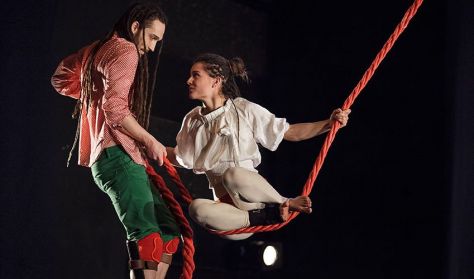
Virtus • Duda Éva Társulat
A Virtus az első olyan magyar produkció, amely a kortárs tánc és az underground cirkuszi világ ötvözéséből született, lendületes zenével, a színházi tér számos síkját kihasználva, sajátosan magyar ízzel. több

A Virtus az első olyan magyar produkció, amely a kortárs tánc és az underground cirkuszi világ ötvözéséből született, lendületes zenével, a színházi tér számos síkját kihasználva, sajátosan magyar ízzel. több
Ön egy múltbeli eseményre keresett. Kérjük, válogasson aktuális kínálatunkból a Jegy.hu keresőjében!
Utolsó előadás dátuma: 2019. november 22. péntek, 19:00
A kortárs tánc területén jól ismert csapat a levegő meghódítására vállalkozva a gravitáció erőinek legyőzését virtuóz magasságokban keresi, miközben virtuóz módon, hatalmas gólyalábakon néptáncol, mindezt pedig életörömmel teli virtuóz élőzenére teszi. Az alkotók-előadók humorral ábrázolják a sajátosan magyar élethelyzeteket és az emberi kapcsolatokban rejlő feszültségeket. Igazi kelet-európai virtus magyar lelkületből: fellengzős érzelmek, hősködő ritmus, bánatos kesergés, dicső cirkusz, és mindez virtuóz táncokkal.
Az emberiség mára nagyon eltávolodott eredendő, természetes közegétől. Miközben vágyunk egy harmonikusabb életre, nap mint nap mégis egyre nagyobb a zűrzavar, amelyben egyre nehezebb eligazodni és egészségesen élni.
Fragment 24 A Hazám (Má vlast) a neves cseh zeneszerző, Bedřich Smetana hat szimfonikus költeményből álló ciklusa, amely a szülőföldje iránti szeretetben gyökerezik. A mű a cseh táj szépségeit, a főbb nemzeti legendákat, és részben a valós történelmi eseményeket ünnepli.
Szerelmi vágy, szerelmi álom Emléke, fénye űz feléd, Keresem az elvesztett édent, Remények, álmok édenét... Amikor én rajongó vággyal Követlek,…
A Győri Balett előadása a világirodalom egyik leghíresebb románca, az Anna Karenina táncszínházi adaptációja, amelyet Velekei László Seregi- és Harangozó-díjas…
A LÉTEZÉS egy tangó táncszínházi alkotás, amely az emberi élet útját járja be – a fiatalság sodró lendületétől az öregkor…
tétel a kosárban
összesen:
Lejárt a vásárlási időkorlát! Kérjük, állítsa össze a kosarát újra!
